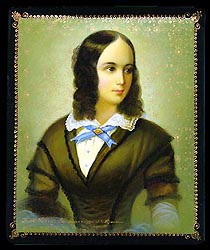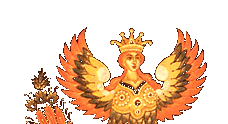 Natalia Nikolaevna Pushkin lived from 1812 until 1863. Her mother's full name was Natalia Ivanovna Goncharova.
The Goncharova girls were brought up in a convent-like atmosphere with their mother being their instructor in manners and etiquette. Abiding by strict rules was the norm for the girls, having to wake at dawn and be in bed by ten at night. They went to church every Saturday for vespers and every Sunday for liturgy. Their parents made them speak in a hush voice, not giving them permission to discuss any passionate feelings they might have on any particular subject with anybody and were not allowed to talk back to anyone. Reading any modern risque novels was out of the question, making their education a basis of dance and learning the intricacies of the French language rather than their native Russian tongue.
Natalia Nikolaevna was the youngest of the three Goncharova sisters. She was charming, beautiful, and at the tender age of 16 was introduced to Moscow's aristocratic society. Young Natalia immediately received the attention and recognition of being one of the most beautiful women in Moscow. Natalia Nikolaevna Pushkin lived from 1812 until 1863. Her mother's full name was Natalia Ivanovna Goncharova.
The Goncharova girls were brought up in a convent-like atmosphere with their mother being their instructor in manners and etiquette. Abiding by strict rules was the norm for the girls, having to wake at dawn and be in bed by ten at night. They went to church every Saturday for vespers and every Sunday for liturgy. Their parents made them speak in a hush voice, not giving them permission to discuss any passionate feelings they might have on any particular subject with anybody and were not allowed to talk back to anyone. Reading any modern risque novels was out of the question, making their education a basis of dance and learning the intricacies of the French language rather than their native Russian tongue.
Natalia Nikolaevna was the youngest of the three Goncharova sisters. She was charming, beautiful, and at the tender age of 16 was introduced to Moscow's aristocratic society. Young Natalia immediately received the attention and recognition of being one of the most beautiful women in Moscow.
 Natalia Nikolaevna was introduced to Alexander Pushkin at her first Ball that she attended in 1828. She was dressed in a gorgeous white dress with a golden crown. Russia's most famous poet fell in love at first sight of Natalia. His friend, Duke Tolskoi-Americanets recorded Alexander Pushkin referring to Natalia as his destiny.
By this time Natalia still had not read any of Pushkin's poetry. In 1829 Pushkin asked for Natalia's hand in marriage. Though he was not refused, the parents declined because Natalia was too young.
Shortly after, Pushkin left to partake in the war that broke out in the Caucuses. He kept a strict correspondence with Natalia through letters he wrote to Natalia's mother.
After the return from his military campaign the poet settled in St. Petersburg. In the meantime Pushkin was invited to visit the Goncharov's household in Moscow.
Pushkin made his second proposal to Natalia on April 6, 1830 and this time her mother's approval was granted. The wedding was held February 18, 1831 at the Great Resurrection Cathedral on Bolshaya Nikitskaya in Moscow. During the wedding ceremony Pushkin's ring fell to the floor and his candle blew out, which Pushkin took as bad omens.
Natalia Nikolaevna and Alexander Sergeevich's marriage was troubled right from the start. The couple's expenses grew rapidly and according to Pushkin they needed twenty to thirty thousand rubles annually to maintain their lavish high society life style. Pushkin would constantly visit friends and creditors for loans, resulting in a sixty thousand ruble debt that piled up by the end of their first four years of marriage. By his death Pushkin owed over one hundred and twenty thousand rubles in debt.
Natalia Nikolaevna continued to frequent St. Petersburg's balls and social royal functions, which made her an object of the Tsar's affection. Rumors of her numerous affairs made life for Pushkin miserable. Among her affectionate followers was the French baron Dantes. A legitimist, he left France shortly after the Revolution, and was accepted into Russia's leading Imperial cavalry regiments as an officer.
Eventually the allegations of her romance with the Frenchman led to Pushkin's demise. A duel between Dantes and Pushkin led to a mortal wound inflicted on Russia's most famous poet.
Alexander Pushkin died in his bed several days later. With the agonizing pain that he was going through in those final days he tried to comfort his wife by not really showing emotionally and physically he was hurting.
As Pushkin passed from one life to another Natalia was in tears, kissing his forehead, chest and arms. She cried for him to forgive her calling out, "Pushkin, Pushkin, are you alive?"
Natalia and their children were left fatherless and in enormous debt. Luckily the Tsar took the burden of care and financial worries upon himself. Pushkin's creditors were paid in full from the royal treasury and Natalia received the amount of ten thousand rubles, given a pension, and Pushkin's children all received royal pensions.
Natalia Nikolaevna Pushkin left St. Petersburg shortly to stay at her brother's estate. She returned to Petersburg two years later and had an encounter with the Tsar in an English store where St. Petersburg's elite went to buy Christmas decorations. The two had a friendly conversation and within a few days Natalia was invited to attend a royal costume ball.
The gorgeous widow arrived dressed as an ancient Jewish princess. The Tsar was delighted and introduced her to his wife. The royal portrait painter was immediately called upon to capture Natalia's beauty on canvas.
Natalia's life changed again, and she was accepted back by high society. In 1844 she married a cavalry major general P.P. Lansky. The Tsar was present at their ceremony and presented Natalia with a diamond necklace. He also insisted on being invited to the baptism of the couple's first child.
Natalia Nikolaevna was last seen in Nice in 1862. According to Prince V.M. Golitsin's memoirs she still looked like a Greek goddess.
Story based on historical facts and excerpts from a novel by V. Korolenko "Pushkin's Companions" Profizdat, 1996. Edited by Gabe Skvor Natalia Nikolaevna was introduced to Alexander Pushkin at her first Ball that she attended in 1828. She was dressed in a gorgeous white dress with a golden crown. Russia's most famous poet fell in love at first sight of Natalia. His friend, Duke Tolskoi-Americanets recorded Alexander Pushkin referring to Natalia as his destiny.
By this time Natalia still had not read any of Pushkin's poetry. In 1829 Pushkin asked for Natalia's hand in marriage. Though he was not refused, the parents declined because Natalia was too young.
Shortly after, Pushkin left to partake in the war that broke out in the Caucuses. He kept a strict correspondence with Natalia through letters he wrote to Natalia's mother.
After the return from his military campaign the poet settled in St. Petersburg. In the meantime Pushkin was invited to visit the Goncharov's household in Moscow.
Pushkin made his second proposal to Natalia on April 6, 1830 and this time her mother's approval was granted. The wedding was held February 18, 1831 at the Great Resurrection Cathedral on Bolshaya Nikitskaya in Moscow. During the wedding ceremony Pushkin's ring fell to the floor and his candle blew out, which Pushkin took as bad omens.
Natalia Nikolaevna and Alexander Sergeevich's marriage was troubled right from the start. The couple's expenses grew rapidly and according to Pushkin they needed twenty to thirty thousand rubles annually to maintain their lavish high society life style. Pushkin would constantly visit friends and creditors for loans, resulting in a sixty thousand ruble debt that piled up by the end of their first four years of marriage. By his death Pushkin owed over one hundred and twenty thousand rubles in debt.
Natalia Nikolaevna continued to frequent St. Petersburg's balls and social royal functions, which made her an object of the Tsar's affection. Rumors of her numerous affairs made life for Pushkin miserable. Among her affectionate followers was the French baron Dantes. A legitimist, he left France shortly after the Revolution, and was accepted into Russia's leading Imperial cavalry regiments as an officer.
Eventually the allegations of her romance with the Frenchman led to Pushkin's demise. A duel between Dantes and Pushkin led to a mortal wound inflicted on Russia's most famous poet.
Alexander Pushkin died in his bed several days later. With the agonizing pain that he was going through in those final days he tried to comfort his wife by not really showing emotionally and physically he was hurting.
As Pushkin passed from one life to another Natalia was in tears, kissing his forehead, chest and arms. She cried for him to forgive her calling out, "Pushkin, Pushkin, are you alive?"
Natalia and their children were left fatherless and in enormous debt. Luckily the Tsar took the burden of care and financial worries upon himself. Pushkin's creditors were paid in full from the royal treasury and Natalia received the amount of ten thousand rubles, given a pension, and Pushkin's children all received royal pensions.
Natalia Nikolaevna Pushkin left St. Petersburg shortly to stay at her brother's estate. She returned to Petersburg two years later and had an encounter with the Tsar in an English store where St. Petersburg's elite went to buy Christmas decorations. The two had a friendly conversation and within a few days Natalia was invited to attend a royal costume ball.
The gorgeous widow arrived dressed as an ancient Jewish princess. The Tsar was delighted and introduced her to his wife. The royal portrait painter was immediately called upon to capture Natalia's beauty on canvas.
Natalia's life changed again, and she was accepted back by high society. In 1844 she married a cavalry major general P.P. Lansky. The Tsar was present at their ceremony and presented Natalia with a diamond necklace. He also insisted on being invited to the baptism of the couple's first child.
Natalia Nikolaevna was last seen in Nice in 1862. According to Prince V.M. Golitsin's memoirs she still looked like a Greek goddess.
Story based on historical facts and excerpts from a novel by V. Korolenko "Pushkin's Companions" Profizdat, 1996. Edited by Gabe Skvor
|



